

Google. Dorothea Lange's "Migrant Mother" Photographs in the Farm Security Administration Collection: An Overview. The photograph that has become known as "Migrant Mother" is one of a series of photographs that Dorothea Lange made of Florence Owens Thompson and her children in February or March of 1936 in Nipomo, California.

Lange was concluding a month's trip photographing migratory farm labor around the state for what was then the Resettlement Administration. In 1960, Lange gave this account of the experience: I saw and approached the hungry and desperate mother, as if drawn by a magnet. I do not remember how I explained my presence or my camera to her, but I do remember she asked me no questions. I made five exposures, working closer and closer from the same direction. The Open Photography Forums Initiative. By Michael Stones How valid is the belief that darkroom or digital work cannot salvage a bad photograph?
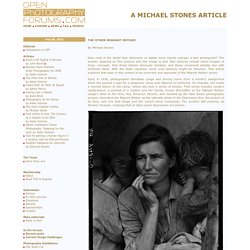
The answer depends on the reasons why the image is bad. Bad pictures include sharp images of fuzzy concepts, that Ansel Adams famously berated, and those conceived adeptly but with technical flaws. With the flaws repaired, some such pictures might be fabulous. This article explores that topic in the context of an overview and appraisal of the Migrant Mother series. Early in 1936, photographer Dorothea Lange was driving home from a month’s assignment when she passed a sign for a peapicker camp near Nipomo in California. Lange’s titles her pictures locate them only with respect to demographics and geography (“Migrant agricultural worker’s family”, “Destitute peapickers in California; a 32 year old mother of seven children.”).
“I saw and approached the hungry and desperate mother, as if drawn by a magnet. That help came quickly. The Story of the "Migrant Mother" By Ben Phelan Posted: 4.14.2014 In 1936 Florence Thompson allowed Dorothea Lange to photograph her family because she thought it might help the plight of the working poor.
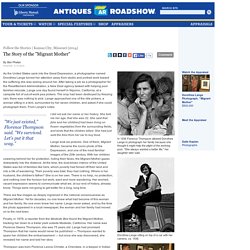
"She always wanted a better life," her daughter later said. Dorothea Lange sitting on top of a car with her camera, ca. 1936. Prints & Photographs appraiser Daile Kaplan and host Mark Walberg discussed the iconic work of early 20th-century photojournalist Dorothea Lange at the Nelson-Atkins Museum in Kansas City. As the United States sank into the Great Depression, a photographer named Dorothea Lange turned her attention away from studio and portrait work toward the suffering she was seeing around her. "We just existed," Florence Thompson said. I did not ask her name or her history. Lange took six pictures. There are few images as deeply ingrained in the national consciousness as Migrant Mother.
Looking at Dorothea Lange’s Migrant Mother. Something appears to have been mixed up here, since the photograph above is not the well-known Migrant Mother photograph by Dorothea Lange.
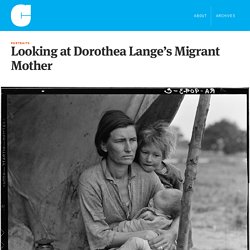
However, it is, unmistakably, the mother from that photograph. What I’m going to do in the following is to try to investigate how portraiture works (at least in part) by using a set of Lange’s photographs, namely the Migrant Mother ones that can be found in the Library of Congress. (For this article, I’m using the scans from the LOC scans, hence the frames and the writing around the image) There are all kinds of reasons for me to pick these images, the most important ones being that everybody knows the most well-known picture, while only few people have ever seen the other ones.
In fact most people don’t even seem to be aware of them. I’m going to ignore all background information about these photographs other than what is available in the LOC, since I want to discuss what can be seen in the photos. What do we actually see here? Let’s keep looking. Migrant Mother, 1936. The image of a worn, weather-beaten woman, a look of desperation on her face, two children leaning on her shoulders, an infant in her lap; has become a photographic icon of the Great Depression in America.
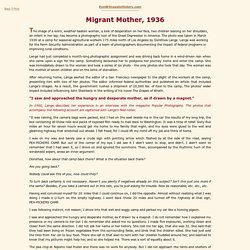
The photo was taken in March 1936 at a camp for seasonal agricultural workers 175 miles north of Los Angeles by Dorothea Lange. Lange was working for the Farm Security Administration as part of a team of photographers documenting the impact of federal programs in improving rural conditions. Lange had just completed a month-long photographic assignment and was driving back home in a wind-driven rain when she came upon a sign for the camp. Something beckoned her to postpone her journey home and enter the camp.
Visual Analysis. New Developments in the Interpretative Analysis of Video and Photography. Volume 9, No. 3, Art. 14 – September 2008 Visual Analysis.
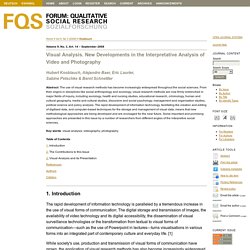
New Developments in the Interpretative Analysis of Video and Photography Hubert Knoblauch, Alejandro Baer, Eric Laurier, Sabine Petschke & Bernt Schnettler Abstract: The use of visual research methods has become increasingly widespread throughout the social sciences. From their origins in disciplines like social anthropology and sociology, visual research methods are now firmly entrenched in major fields of inquiry, including sociology, health and nursing studies, educational research, criminology, human and cultural geography, media and cultural studies, discursive and social psychology, management and organisation studies, political science and policy analysis. Key words: visual analysis; videography; photography.